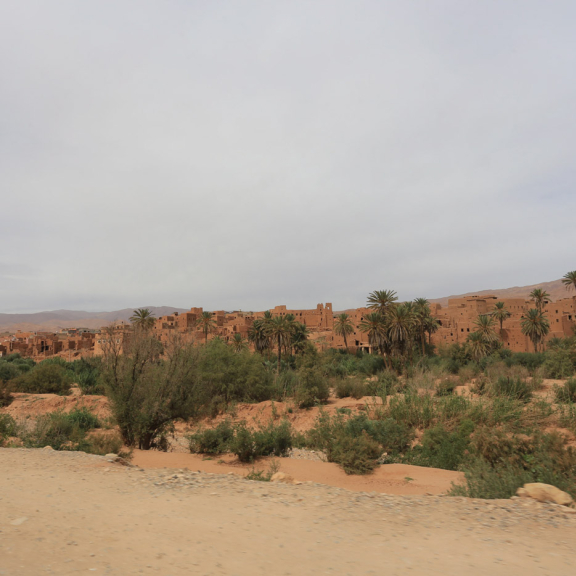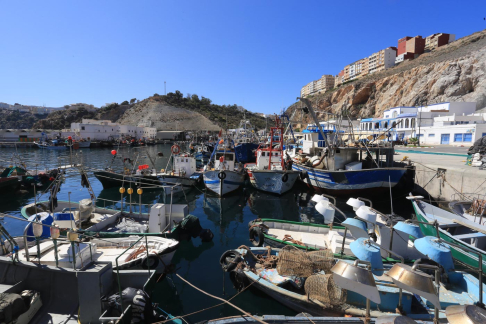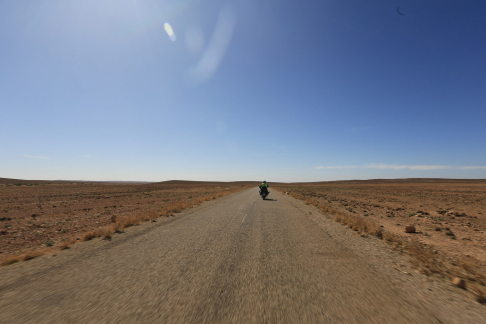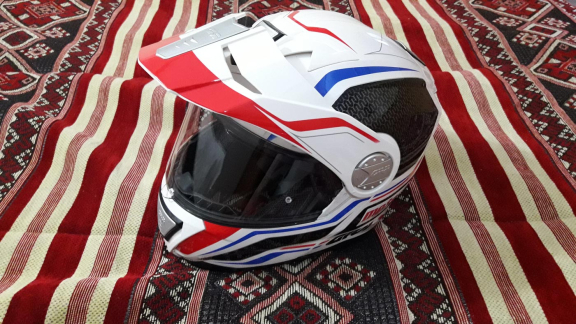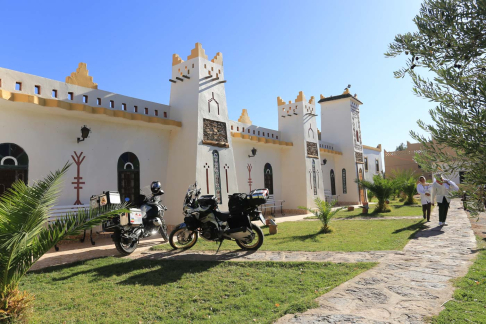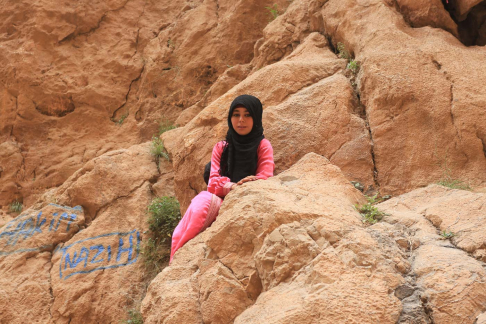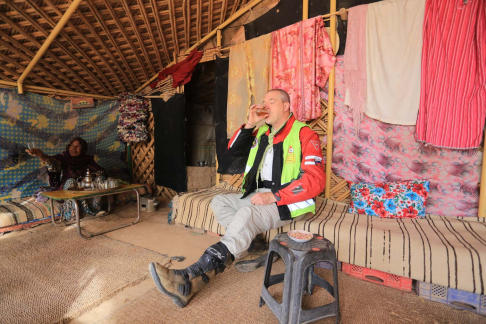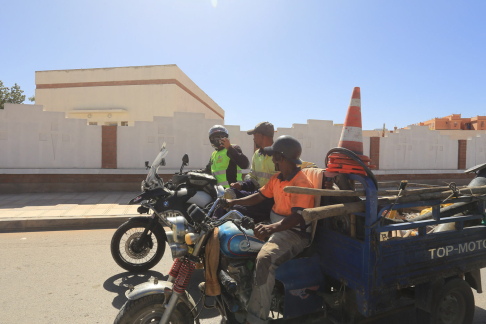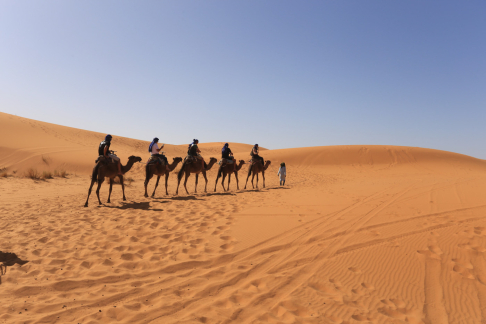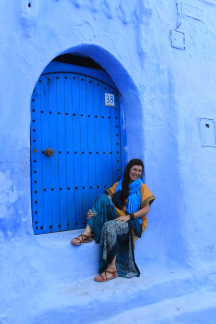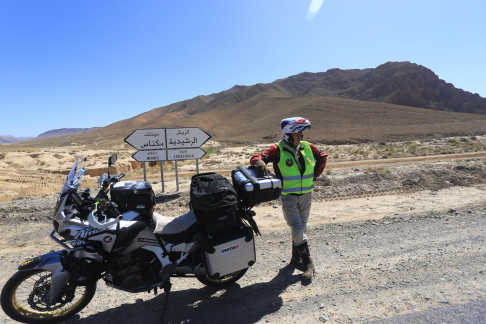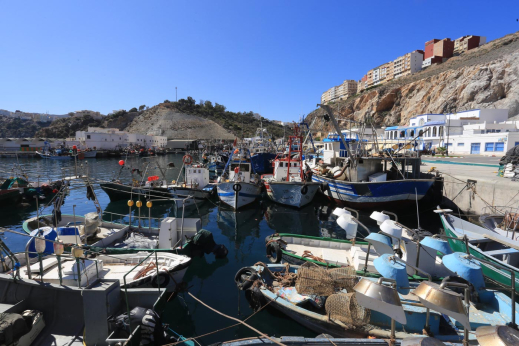Morocco: Between The Sea and The Desert
Morocco Tour by motorbike
Slovenian journalist and motorcyclist Mitja Gustincic describes for us his experience of crossing Morocco on two wheels, with a humorous and (self-) critical take. His travel companion: an Africa Twin Adventure Sports, fully fitted out for the journey.
Motorcycle used: Honda Africa Twin Adventure Sports
Total distance travelled: around 5,000 km
Weather conditions: temperatures from +10˚C to +15˚C in the EU, light rain; from +12˚C to 30˚C in Morocco, dry conditions.
Setting out
The port of Genoa in the first week of October 2019: in temperatures fluctuating around 12 degrees, cars, lorries and a few dozen motorcycles queued up to board a GNV (Grandi Navi Veloci) ferry.
Our destination: Tanger-Med.
The estimated journey time was 3 days; or, rather, two full days and nights plus twelve or so hours, with the ferry travelling at around 40 km/h.At first glance, travelling by sea might seem to be a huge waste of time, but that’s not how I see it! Instead, I believe that it has to be taken as a chance to enjoy a long, refreshing sleep, read a book, and prepare both mind and body for the accelerated rhythms of life in the wonderful country that lies ahead: Morocco. A note of caution: visiting the country on a motorcycle is a project, not a simple weekend excursion.Before delving into the heart of this terrain, I think it is vital to mention the topic of border crossings and reflect on a topical word: Brexit! Everybody should think back to the times when thorough inspections were a part of crossing national borders. Remember the infinite hours waiting to cross from one country to another inside Europe? Today, travelling inside the EU is so easy that we have completely forgotten about that problem: just shift from sixth to third gear – and hit the gas!
How much luggage should you bring?
I had the good fortune to meet an interesting man at the Port of Genoa: Claus Sivieri, an Italian motorcyclist aged 67, riding the “40-year-old” Cagiva Elefant 650. His jacket and the livery of his motorcycle bore evidence of many previous trips to Africa. And guess what else I noticed? For a journey lasting 3 weeks and 5,000 km, Claus had brought with him a small rucksack and an equally compact bundle rolled up and attached to his motorcycle: his tent. His route was to take him across the Sahara. My own motorcycle, on the other hand, was weighed down like a lorry… Too late, I realised that the difference was the excessive amount of clothes I had decided to bring with me. I had completely forgotten about the climate of Morocco. Take Fes as a benchmark: to the south of the city, the air is extremely dry and daytime temperatures can reach 30 degrees, even in October. You can hand-wash your clothes every evening, hang them from the window (yes, you need a line), and find them dry in the morning. As a result, 3 sets of underwear is the ideal amount to bring on your trip.
When the sun sets, however, temperatures sink to 10 degrees. When this happens, you will need a warm fleece and a cap. No sooner had the front wheel of my Africa Twin Adventure Sports met the orange sand of the Sahara, close to the city of Merzouga, than I understood that these bulky “beasts” fitted with street tyres aren’t exactly ideal for rough terrain.
The 176 litres worth of luggage I had brought (excessive clothing, some tools, a camera and computer, food) further complicated the situation.
If you expect to ride over dunes and dirt roads, take greater care with the luggage you bring than I did (the bare minimum), choose a light, powerful motorcycle, and make sure you have all the necessary skills and equipment.
Big cities or unspoiled landscapes?
This is an interesting question, with a very simple answer. Every big city centre, boasting shopping malls and elegant international shops, always has something artificial about it. Luckily, this is not the case in the countryside. Here, you can get lost in the back streets, minor roads and villages, where the colours blend into nature. It is difficult to suggest what to prioritise: what’s unmissable, which streets you should take. Once you begin to explore, you immediately realise that you will have to come back, again and again.
I can attest that Fes is a real gem for anyone who, like me, is not a fan of mass tourism, and that it definitely deserves a visit of at least two days. Marrakesh is far more popular with tourists and, as a result, may seem less authentic. The cost of living is also higher, and vendors much less patient.
Naturally, Marrakesh is interesting and charming, but life is purer in the small villages. So don’t drive through in a hurry, but make your way gradually through the rural centres to witness the daily lives of the people who live there: the children on their way to school, merchants preparing their stalls…
Don’t be caught by surprise by the many permanent road blocks of the police or the Royal Gendarmerie: they are well signalled and there is also a stop sign, so respect these instructions and slow down. The officials immediately recognise tourists, and allow them to proceed.
The police also perform speed checks often. Like anywhere else, it is important to respect the rules as well as common sense in Morocco, both in and out of the saddle. Western women, for example, are advised not to walk around the cities half-naked; not as a question of religion, but as a question of respect.
During my journey, I often stopped off in small squares just to sit and enjoy a mint tea, or a coffee. From my table, I could people-watch, listen to voices and music, and smell the scents that spread throughout the air.
The round tour
recommended for newcomers to Morocco
For your first trip to Morocco, I recommend a round tour. Mine took me east, going inland.
The road from the port of Tanger-Med, skirting the Mediterranean coast towards Oujda, is magnificent: the landscape is fascinating, while also being similar to that of Italy, Spain or Greece. In the city of El Hoceima, I recommend taking a trip to the fishing port and visiting the fish restaurant in the bay. Here, it is possible to experience an atmosphere which is still “familiar” to prepare your stomach for Moroccan cuisine… and for the absence of alcoholic drinks. Bottled water, mint tea, orange juice and Coca Cola will keep you going.
I like to begin the day with an early breakfast. At 7:30 a.m. or 8:00 a.m. at the latest, the engine should be running. Before engaging the gear, check your fuel tank. Keeping it full will save you from wasting time during the day. My Africa Twin let me cover up to 400 km without stopping to refuel. It’s one less thing to think about, and you can relax in the knowledge that you need only stop at places of interest along your route.
For example, Merzouga: a small town nestled in the fine sand towards the south-east, close to the border with Algeria. Here, the dunes of the Sahara are on display in all their glory: a Mecca for off-road lovers!
You can walk over the dunes, travel on the backs of camels (or, to give them their proper name, dromedaries), or simply sit down in the shade of a palm tree, drinking a sweet mint tea and watching as the colours and shapes of the sand transform throughout the day. A truly spectacular show.
This is the point where you will realise that time is essential for a trip through Morocco. If your goal is to get the very most out of your surroundings, you can travel no more than 350 km per day. This means you should allow a minimum of two weeks, plus one week’s travel time to and from home.Turning back to the Mediterranean coast, the countryside here gradually turns mountainous as you pass through the region of Rif, which separates the sea from the inland area. Crossing the Rekkam plateau, going towards Midelt and Errachidia, is a very relaxing experience. This uninhabited area is not far from the Algerian border.
Bit by bit, the road leads the traveller into another world, made up of deserts, dried-up riverbeds, red and orange landscapes and the edge of the Sahara.
Your first window onto the desert is close by, followed by the city of Errachidia on the Ziz River — oases filled with palm trees, and air temperatures of 34 degrees at 5:00 p.m.
Merzouga, an enchanting place to halt for a day or two, is the last stop-off before the roads become… challenging.
The cities of Erfoud and Rissani are like gateways into the desert.
However, Morocco is more than just sand and mountains. On its Atlantic coast, fascinating cities and breathtaking landscapes are to be found. The ancient fishing city of Essaouira, for example, will astound you with its colours. The area between Essaouira and Agadir is famous worldwide for its many Argan trees, known to the locals as “goat trees”.
Argan oil is an extraordinary and well known product, but refrain from purchasing it in the souqs or tourist shops. You’d be better off stopping at a “women’s argan co-operative”, where local women produce and sell argan-based oil and products.
The ancient, crowded and labyrinthine cities are well worth a visit, but be careful you don’t get lost! Not even an excellent sense of direction will grant you an easy escape; so, for your first time, it might be better to explore with the help of a local guide, particularly in the city of Fes.
In conclusion, a trip to Morocco is an essential element on the “curriculum” of any lover of two-wheeled tourism. To enjoy it fully, however, I think the right length of time and the right attitude are essential to truly appreciate all the natural and cultural wonders that this country can offer.
The protagonist
Mitja Gustincic
The protagonist
Mitja Gustincic
Journalist and motorcyclist.
Equipment
To tackle this journey, I kitted the motorcycle out with a number of GIVI products, including the GRT715 tank bag, the T513 side bags for front mounting on the engine guard, the S350 trekker straps, the T518 travel set for clothing, the T508 internal bags (for hard cases) and some other small accessories…
I was pleasantly surprised by the set, but I particularly liked the UT806/65L saddle bag, which I found useful, excellently designed and well made, and the STF500S thermal flask, which is also perfect for trekking.
Usually, I tend not to take new helmets on my journeys, but I have to admit that I had no problems with the modular GIVI X33 Canyon, with its high comfort level — particularly in relation to the affordable price — agreeable fit and the quality of the padding, which is absolutely impervious to unpleasant odours… even after hours of driving through the desert!
To tackle this journey, I kitted the motorcycle out with a number of GIVI products, including the GRT715 tank bag, the T513 side bags for front mounting on the engine guard, the S350 trekker straps, the T518 travel set for clothing, the T508 internal bags (for hard cases) and some other small accessories…
I was pleasantly surprised by the set, but I particularly liked the UT806/65L saddle bag, which I found useful, excellently designed and well made, and the STF500S thermal flask, which is also perfect for trekking.
Usually, I tend not to take new helmets on my journeys, but I have to admit that I had no problems with the modular GIVI X33 Canyon, with its high comfort level — particularly in relation to the affordable price — agreeable fit and the quality of the padding, which is absolutely impervious to unpleasant odours… even after hours of driving through the desert!

